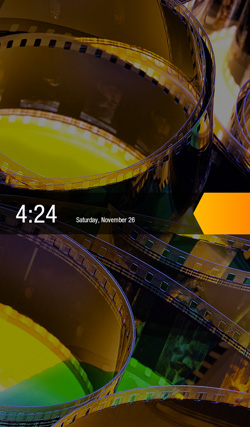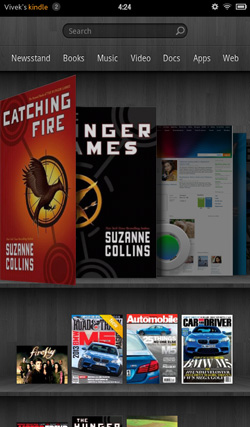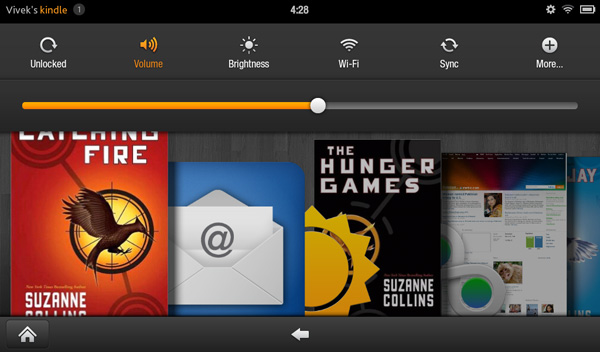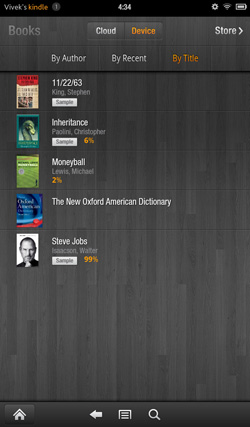Amazon Kindle Fire Review
by Anand Lal Shimpi & Vivek Gowri on November 29, 2011 3:31 AM EST- Posted in
- Tablets
- Mobile
- Amazon
- Kindle Fire
- Kindle
The Operating System
There are three reasons why the Kindle Fire is one of the most important tablet releases of the year: software, services, and shopping. The hardware, while nice, plays a definite secondary role here. The user experience, with tight-knit integration with Amazon's full suite of digital media services (Kindle, Appstore for Android, MP3 Cloud Player, and Prime Instant Video), is what makes the Kindle Fire the most formidable threat.
Amazon and Lab 126 have taken the same route as Barnes and Noble here and built the Kindle Fire operating system on top of Android 2.3. This is basically a skinned version of Gingerbread just as you'd find on an HTC Flyer or the old Galaxy Tab 7", but instead of augmenting the stock Android experience, the goal here is to hide it entirely. When you press the (stupidly located) lock button, you're treated to a simple lock screen, featuring a high resolution image of Amazon's choosing and an orange lock slider with the day, date, and time. Note that you cannot change the lockscreen image without rooting the device.
Slide the bar over to get to the homescreen, and you find yourself looking at a virtual bookshelf of apps. The top shelf is called the Carousel. It's a rotating, Cover Flow-style list of recently used files and applications that you can swipe through. It's nice, in that you can switch between your recent windows, but there's too many app windows that are stored. This leads to two problems: there can be some choppiness in the animation if you try to scroll through the entire list quickly, and overall it's a bit visually chaotic and disorganized. It's good, but it'd be better if they shortened the list to just the last 8-10 items. The shelves underneath are made up of items you deem "favorites". You can pin almost any content to the mainscreen - applications, magazines, newspapers, books, albums, playlists, videos, documents, websites; just hold down the icon/cover to add to favorites, then it'll show up on your homescreen. 4 icons per shelf, and the size of your bookshelf grows downwards as you add more content to it. However, as you add more content, scrolling through the bookshelf tends to get a bit choppy.
The notification bar from Android 2.x is still there, but the notification drawer is a push-button affair instead of a slide-down windowshade. The left side of the notification bar contains the battery and WiFi indicators as well as a small gear. Press it to bring down the quick setting options, and select "More..." to get to the full settings menu. The quick settings options are the rotation lock, volume and brightness controls, wireless settings, and a manual sync button. The main menu settings are relatively limited compared to normal Android, mostly account and security options, along with the standard device settings: sounds, display timeout, keyboard, network, date/time, and application permissions. The notification tone catalogue is basically lifted from Honeycomb, as are the keyboard touch sounds. The sounds are basically the only personalization options you've got. There's no real wallpaper to speak of other than the dark gray bookshelf, and as mentioned before, you can't touch the lockscreen images.
There are no hardware buttons, so the standard Android navigation buttons show up on a bottom navigation bar. The Home button and back button are always present, joined by the menu button and search when relevant. The menu bar disappears when you're viewing print or video content, necessitating a touch of the screen to bring up the navigation bar.
Above the Carousel is a list of the different content areas. You can access the web or one of the content libraries by hitting the corresponding name: Newsstand, Books, Music, Video, Docs, Apps, Web. Web takes you to the browser, Apps takes you to the main application launcher, and the rest of the content areas are mostly self-explanatory. It's the only way to access the browser, the launcher, and the music player, so you'll use those buttons often. Above the content libraries is a search box that searches through your books, magazines, documents, movies, music, and apps. We'll cover all of these systematically, starting with the browser, which Amazon says is "cloud-accelerated" using the computing back-end of Amazon Web Services. It's called Silk.















70 Comments
View All Comments
Reflex - Friday, December 2, 2011 - link
So come back in February. By then we'll be on the cusp of a new generation of devices. Right now the Playbook is defficient. Its a nice set of hardware with a lacking software stack. Out of the box it simply does not do what most people want. When it does, I'm sure AT will check it out, but having them review it now is likely to simply get it slammed since it simply won't work for most people who do not already own a BB.ComputerGuy2006 - Tuesday, November 29, 2011 - link
The "final words" section says "The Kindle Fire is probably the best tablet you can buy at $199.". This is troubling.It was never explained how a $200 playbook isnt as good as the $200 kindle. Seems to me the playbook has double the ram and double the storage space. The playbook has two camera and a micro-HDMI port.
So as long RIM can keep its promise and make the playbook capable of running android apps, I dont see how the kindle can beat the playbook in ANYWAY unless you want to spend lots of money on the amazon app store.
VivekGowri - Wednesday, November 30, 2011 - link
Honestly, as tempting as the PB is at $199, RIM's utter failure to deliver features that were promised at launch even 8 months after release is pretty worrying. The lack of native email, contacts, and calendar as of December 2011 is blatantly unacceptable.doesitreallymatter - Friday, December 2, 2011 - link
It is unacceptable that those key apps are lacking. In 2 months when/if RIM delivers these apps, what will be your opinion then?As long as those apps are delivered along with the android support, I just don't see how the Fire can compete with the playbook.
I just don't understand how the conclusion has no mention of the playbook at all.
Reflex - Friday, December 2, 2011 - link
It also does not mention the Nook Tablet. Why? Because it hasn't been reviewed it. If the Playbook becomes competitive, and thats a big if honestly, I'm sure they'll take a look. But really, February? You mean almost a year after the device they give it basic functionality everyone else has shipped with from the beginning?For me, even if the Playbook was competitive, I just can't see that as a well supported platform worth me investing into the ecoysystem of.
dgburns - Wednesday, December 7, 2011 - link
Perhaps you missed the announce a while ago that RIM has dropped the Android App Player from development? So your touted "android support" isn't coming....dgburns - Wednesday, December 7, 2011 - link
The Playbook will NEVER have the ecosystem Amazon delivers with the Fire. As many commentors have implied, that's a HUGE differentiator.And to those who say the PlayBook is the better device at $199 if you own a BlackBerry smartphone already, I disagree. I've got TWO BlackBerry smartphones (different models, from two employers) and as nice as the PlayBook hardware is I STILL don't want one. Even "bridged" to a BB, the PlayBook is SO limited. Will it get better come February (or whenever RIM REALLY releases a update)? Probably, but even then it won't have the ecosystem the Fire brings.
jedivulcan - Tuesday, November 29, 2011 - link
I wish this review went into a bit more nitpicking with the display like I've seen with the other AnandTech reviews. In my experience with having two Kindle Fires, the displays are so wildly different that it's almost like looking at two different products when you have them side by side.The first Kindle Fire I received from Amazon on the day it came out had a duller backlight, some backlight bleeding when viewing older television shows on Netflix, and warmer, almost yellow colors, one or two dead pixels, and hit or miss viewing angles.
The second one I got a week later had a brighter backlight, a ton of backlight bleeding, bright dead pixels on the screen (very apparent in one location), cool blue washed out colors, and terrible viewing angles.
https://img.skitch.com/20111130-x9fq2qskte8kas62jg...
https://img.skitch.com/20111130-dm18ykeb8kud98w4t2...
Reflex - Tuesday, November 29, 2011 - link
Totally bizarre. I'm not implying you haven't seen what you've seen, but I've handled more than a dozen Fire's now and the screens have been consistent with each other and very very high quality. The one I own and took on trips got noticed repeatedly and the first comment most people had was about how nice the screen looked. Its typically the standout feature hardware wise from most people I've discussed it with.Your situation is odd to me because normally I'd suspect a bad run, but you got them a week apart. I really have no idea, but I will say it does not jive with my anecdotal experience or what I"m reading elsewhere. Anyone else see this issue?
VivekGowri - Wednesday, November 30, 2011 - link
Hmmm mine is totally fine, so was Anand's. I really, really like the display quality, though I would have preferred a more neutral colour temperature. I'm not sure why you had so many issues with the display, that's very very odd.